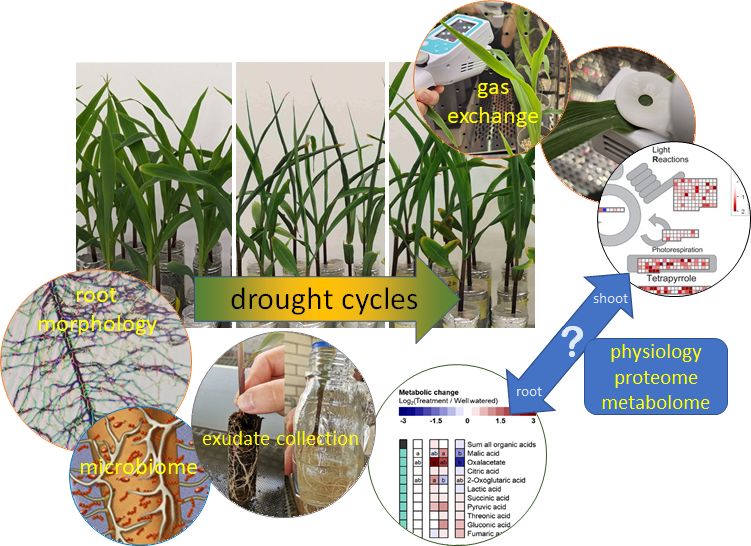P6 - Drought Cycles
Physiological drought stress imprints related to root exudation in the rhizosphere

Physiological drought stress imprints related to root exudation in the rhizosphere
So-called “stress imprints” describe modifications in plants that occur after a stress event, often persist beyond the stress phase, and alter responses to subsequent stresses. In this project, we investigate such “imprints” in the shoot-root-soil-microbiome system of two maize genotypes (WT and rth3 roothairless mutant) in response to single and repeated drought spells. Our main objective is to unravel the spatio-temporal interplay between drought-induced changes in photosynthetic processes aboveground, and their lasting imprints on rhizosphere-based processes belowground, mediated by alterations in root exudates.
The first aim of this project is to assess alterations of different rhizosphere processes such as microbial colonization, nutrient and water uptake or soil physico-chemical processes under drought. The second aim of the project is to unravel whether drought-induced damage to the photosynthetic apparatus directly correlates with changes in root exudates. The third part addresses the question whether drought stress imprints lead to spatio-temporal re-distribution of resources towards the root, which then affect post-stress plant performance with respect to water and nutrient uptake.
Outcome
Aim 1: A central experiment was conducted together with six other PP groups to analyse the effect of a 7d drought on the plant-soil-microbiome continuum of two maize genotypes (WT and rth3). Water limitation led to alterations of microbial diversity more distant from the root surface, while genotype-specific stress-induced increases in exudation modified microbial acitivity in the rhizosphere. The less intense drought response of rth3 was confirmed at all levels of investigation and may be due at least in part to the somewhat smaller plant size of this genotype – pointing out an often underestimated bias in drought stress screening experiments (Hartwig et al. submitted).
Aim 2: The less severe drought stress level of the rth3 mutant was consistently observed in all soil column experiments conducted in climate chambers run in a constant day/night setting for light, temperature and relative humidity (rH). However, in the field all these factors exhibit a diurnal rhythm. Interestingly, when we exposed plants to a diurnal progression of rH similar to field conditions, the stress level was overall stronger, but no longer significantly different between WT and rth3. In addition, the diurnal pattern of stomatal conductance was almost identical for both genotypes in all treatments under these conditions (MSc Weißflog).
In a range of soil column experiments plants were exposed to different drought intensities, durations and speeds of progression. Results indicate that the final drought stress intensity, and not the speed of progression, is decisive for a change in root exudate composition. Increases in dissolved organic carbon, phenolics and sugars in root exudates correlated with a >50% reduction in effective quantum yield of photosystem II, indicating that damage to PSII was necessary to induce these alterations, most likely related to non-stomatal limitation of assimilation rates. Irrespective of the stress progression, the threshold in soil water content that altered exudate amount and composition was between 10-15% (v/v), corresponding to pF 3.2-3.6, for the loamy soil. Adjusting the light intensity to mimick a diurnal pattern similar to field conditions resulted in only minor changes in root exudates (MSc Weißflog).
Despite the less severe stress level of the rth3 mutant, we consistently observed a slightly delayed recovery of water relations in rth3 compared to the WT (MSc Engel, MSc Sterk). To avoid the problem of different stress intensities in both genotypes we harvested each genotype once transpiration rates were reduced to 50% of the well-watered plants. An almost identical relative water content in leaves confirmed a similar physiological stress level in both genotypes with this setting. We again observed a delayed recovery of water relations in the rth3 mutant, indicating that root hairs may contribute to a better recovery and an improved water uptake once the stress is relieved. Whether this results in a better post-stress performance is assessed in ongoing experiments.
Aim 3: Using a splitroot setup, we assessed whether drought-induced stress imprints may affect root morphology. Both genotypes were exposed to water limitation to one root half, allowed to recover for four days, and then exposed to a second drought spell either to the same, or to the other root half. Wild type plants, where the same root half was stressed twice, had a larger final root length compared to plants, where the drought spells were imposed on both root halves alternately. This might be a first indication of a beneficial stress imprint induced by local water limitation, resulting in morphological adaptations of the whole roots (MSc Sterk). However, results from the rth3 mutant are still under evaluation.
Link to English scientific abstract
Link to German scientific abstract
